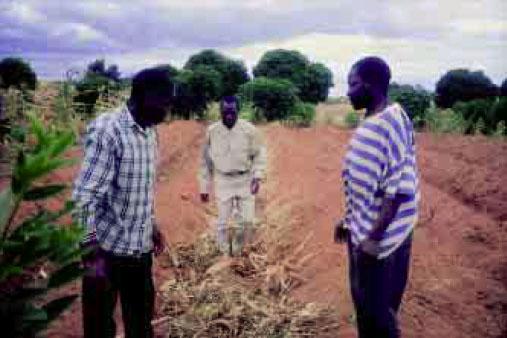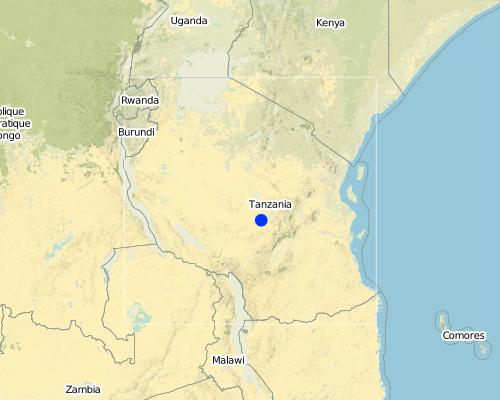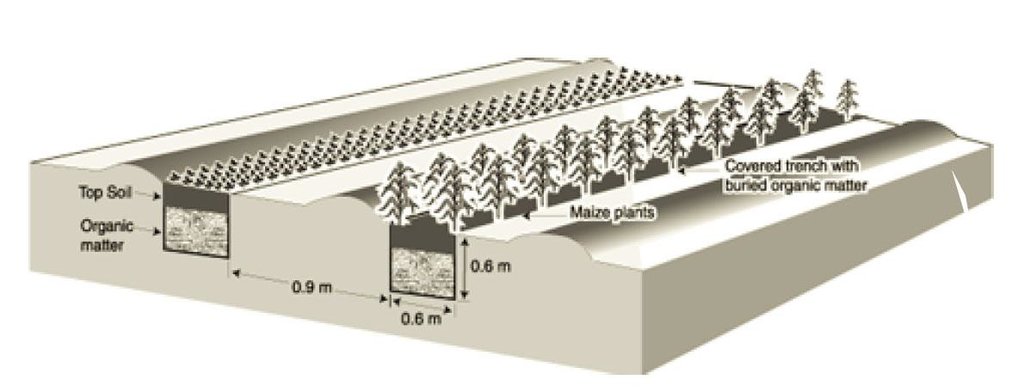In-situ compost cultivation or ‘pattern farming’ [Tanzania, United Republic of]
- Creation:
- Update:
- Compiler: Patrick Gervas Mbanguka Lameck
- Editor: –
- Reviewer: David Streiff
Kilimo cha mfumo (Kiswahili)
technologies_1122 - Tanzania, United Republic of
View sections
Expand all Collapse all1. General information
1.2 Contact details of resource persons and institutions involved in the assessment and documentation of the Technology
Name of the institution(s) which facilitated the documentation/ evaluation of the Technology (if relevant)
Inades Formation Tanzania (Inades Formation Tanzania)1.3 Conditions regarding the use of data documented through WOCAT
When were the data compiled (in the field)?
12/12/1999
The compiler and key resource person(s) accept the conditions regarding the use of data documented through WOCAT:
Yes
2. Description of the SLM Technology
2.1 Short description of the Technology
Definition of the Technology:
In-situ compost trench cultivation
2.2 Detailed description of the Technology
Description:
The system is based on trench cultivation. This involves excavation of trenches 0.6 m deep and 0.6 m wide, more or less across the slope, at a spacing of 0.9 m apart, edge to edge. The trenches are dug in the dry period, then filled with crop residues, grass and other organic trash, and finally back-filled with soil.
The surface is deliberately left some centimetres below ground level so that it can capture runoff. Associated with the trenching, a furrow to harvest rainwater is formed to lead water into the field from outside, and an end bund in the field is built up to prevent its loss. Between trenches a leguminous crop such as groundnuts is grown, while maize, sweet potatoes and tomatoes are grown on the trenches. In the first year, the farmer plants at the sides of the trench to avoid damage to crop roots by the heat generated by decomposition. Thereafter crops are planted in the middle. In years of good rainfall it is possible to grow an opportunistic second crop, making use of stored soil moisture. After four years the trench is re-dug, filled with organic matter, and the cycle begins. Further additions/ improvements to the system (which is
constantly evolving) are (i) the addition of cattle urine and waste water from the household to hasten decomposition of grass materials; and (ii) mulching between the trenches with crop stover at the end of the season.
Purpose of the Technology: The technology comprises a structural measure, dedicated to improvement of the land for annual cropping. In respect to soil and water conservation it primarily addresses soil fertility and soil moisture problems. It achieves impact through increasing organic matter and water stored in the soil. Ecological benefits include increase in soil moisture, improved soil fertility and protection of the land from surface erosion.
Establishment / maintenance activities and inputs: The land was completely bare before the technology and is now productive. Compared with neighbouring farms yields are estimated to be at least 50% higher, and the farmer considers the benefits to be ‘very positive’ in relation to the costs. This is reflected in his increased farm income. Those cost, however, are estimated at around 400 person days per hectare for initial establishment.
Natural / human environment: This technology was designed by a retired agricultural field agent on his 3 ha of land. The importance of this particular innovation lies in the fact that the originator has mixed and matched tradition and modern practices to tailor-make a system that suits his own situation.
2.3 Photos of the Technology
2.5 Country/ region/ locations where the Technology has been applied and which are covered by this assessment
Country:
Tanzania, United Republic of
Region/ State/ Province:
Dodoma
Further specification of location:
Dodoma rural
Map
×2.6 Date of implementation
If precise year is not known, indicate approximate date:
- less than 10 years ago (recently)
2.7 Introduction of the Technology
Specify how the Technology was introduced:
- through land users' innovation
Comments (type of project, etc.):
farmer intiative
3. Classification of the SLM Technology
3.1 Main purpose(s) of the Technology
- improve production
- reduce, prevent, restore land degradation
3.2 Current land use type(s) where the Technology is applied

Cropland
- Annual cropping
Main crops (cash and food crops):
major cash crop and major food crop: Maize
other: Groundnut
Comments:
Major land use problems (compiler’s opinion): declining soil fertility, moderate erosion and declining soil cover
Major land use problems (land users’ perception): as above
3.3 Further information about land use
Number of growing seasons per year:
- 1
Specify:
Longest growing period in days: 120; Longest growing period from month to month: Dec - Apr; Second longest growing period in days: 90; Second longest growing period from month to month: Sep - Dec
3.4 SLM group to which the Technology belongs
- integrated soil fertility management
3.5 Spread of the Technology
Specify the spread of the Technology:
- evenly spread over an area
If the Technology is evenly spread over an area, indicate approximate area covered:
- 10-100 km2
3.6 SLM measures comprising the Technology

agronomic measures
- A2: Organic matter/ soil fertility

structural measures
- S4: Level ditches, pits
Comments:
Type of agronomic measures: legume inter-planting, manure / compost / residues, furrows (drainage, irrigation)
3.7 Main types of land degradation addressed by the Technology

soil erosion by water
- Wt: loss of topsoil/ surface erosion

chemical soil deterioration
- Cn: fertility decline and reduced organic matter content (not caused by erosion)

water degradation
- Ha: aridification
Comments:
Secondary types of degradation addressed: Ha: aridification
3.8 Prevention, reduction, or restoration of land degradation
Specify the goal of the Technology with regard to land degradation:
- restore/ rehabilitate severely degraded land
4. Technical specifications, implementation activities, inputs, and costs
4.1 Technical drawing of the Technology
4.2 Technical specifications/ explanations of technical drawing
Cross-section of compost trench cultivation
Location: Dodoma. Tanzania
Technical knowledge required for field staff / advisors: moderate
Technical knowledge required for land users: low
Main technical functions: control of dispersed runoff: retain / trap, increase in organic matter, water harvesting, increase in soil fertility
Secondary technical functions: reduction of slope length, improvement of ground cover, increase of surface roughness
Legume inter-planting
Remarks: between trenches
Manure / compost / residues
Material/ species: compost, grass, other organic trash
Remarks: trenches filled with organic material
Furrows (drainage, irrigation)
Remarks: to harvest rainwater and bring it into the field
Structural measure: trench 2'*2'
Vertical interval between structures (m): 0.6
Spacing between structures (m): 0.3
Depth of ditches/pits/dams (m): 0.6
Length of ditches/pits/dams (m): 0.15
Height of bunds/banks/others (m): 0.2
4.4 Establishment activities
| Activity | Type of measure | Timing | |
|---|---|---|---|
| 1. | layout, excavation, construction of bunds | Structural | before rains |
| 2. | filling of trash and organic matter | Structural | during rains |
4.5 Costs and inputs needed for establishment
| Specify input | Unit | Quantity | Costs per Unit | Total costs per input | % of costs borne by land users | |
|---|---|---|---|---|---|---|
| Labour | Labour | persons/day/ha | 417.0 | 1.9 | 792.3 | 100.0 |
| Equipment | Tools | ha | 1.0 | 8.5 | 8.5 | 100.0 |
| Plant material | Seeds | ha | 1.0 | 7.5 | 7.5 | 100.0 |
| Total costs for establishment of the Technology | 808.3 | |||||
Comments:
Duration of establishment phase: 12 month(s)
4.6 Maintenance/ recurrent activities
| Activity | Type of measure | Timing/ frequency | |
|---|---|---|---|
| 1. | excavating the trenches | Agronomic | aug-nov / occassionally |
| 2. | collecting of organic matter | Agronomic | before rains / occassionally |
| 3. | burying of the organic matter | Agronomic | before rains / occassionally |
| 4. | sowing of seeds | Agronomic | during rain / annually |
| 5. | harvesting | Agronomic | dry season / annually |
| 6. | after 3 years excavate | Structural | dry season/after 3years |
| 7. | add organic matter | Structural | each cropping season |
4.7 Costs and inputs needed for maintenance/ recurrent activities (per year)
| Specify input | Unit | Quantity | Costs per Unit | Total costs per input | % of costs borne by land users | |
|---|---|---|---|---|---|---|
| Labour | Labour | persons/day/ha | 139.0 | 1.9 | 264.1 | 100.0 |
| Equipment | Tools | ha | 1.0 | 8.5 | 8.5 | 100.0 |
| Plant material | Seeds | ha | 1.0 | 7.5 | 7.5 | 100.0 |
| Total costs for maintenance of the Technology | 280.1 | |||||
4.8 Most important factors affecting the costs
Describe the most determinate factors affecting the costs:
labour for trench cultivation
5. Natural and human environment
5.1 Climate
Annual rainfall
- < 250 mm
- 251-500 mm
- 501-750 mm
- 751-1,000 mm
- 1,001-1,500 mm
- 1,501-2,000 mm
- 2,001-3,000 mm
- 3,001-4,000 mm
- > 4,000 mm
Specifications/ comments on rainfall:
Also 500-750 mm
Agro-climatic zone
- semi-arid
- arid
5.2 Topography
Slopes on average:
- flat (0-2%)
- gentle (3-5%)
- moderate (6-10%)
- rolling (11-15%)
- hilly (16-30%)
- steep (31-60%)
- very steep (>60%)
Landforms:
- plateau/plains
- ridges
- mountain slopes
- hill slopes
- footslopes
- valley floors
Altitudinal zone:
- 0-100 m a.s.l.
- 101-500 m a.s.l.
- 501-1,000 m a.s.l.
- 1,001-1,500 m a.s.l.
- 1,501-2,000 m a.s.l.
- 2,001-2,500 m a.s.l.
- 2,501-3,000 m a.s.l.
- 3,001-4,000 m a.s.l.
- > 4,000 m a.s.l.
Comments and further specifications on topography:
Slopes on average: Also hilly and gentle
Landforms: Also footslopes and valley floors
5.3 Soils
Soil depth on average:
- very shallow (0-20 cm)
- shallow (21-50 cm)
- moderately deep (51-80 cm)
- deep (81-120 cm)
- very deep (> 120 cm)
Soil texture (topsoil):
- medium (loamy, silty)
Topsoil organic matter:
- low (<1%)
If available, attach full soil description or specify the available information, e.g. soil type, soil PH/ acidity, Cation Exchange Capacity, nitrogen, salinity etc.
Soil fertility is low
Soil drainage / infiltration is medium
Soil water storage capacity is medium
5.6 Characteristics of land users applying the Technology
Off-farm income:
- less than 10% of all income
Relative level of wealth:
- poor
- average
Indicate other relevant characteristics of the land users:
Population density: 10-50 persons/km2
Annual population growth: 2% - 3%
3% of the land users are rich and own 35% of the land.
40% of the land users are average wealthy and own 40% of the land.
40% of the land users are poor and own 15% of the land.
17% of the land users are poor and own 10% of the land.
5.7 Average area of land owned or leased by land users applying the Technology
- < 0.5 ha
- 0.5-1 ha
- 1-2 ha
- 2-5 ha
- 5-15 ha
- 15-50 ha
- 50-100 ha
- 100-500 ha
- 500-1,000 ha
- 1,000-10,000 ha
- > 10,000 ha
Comments:
Average area of land owned or leased by land users applying the Technology: Also 1-2 ha
5.8 Land ownership, land use rights, and water use rights
Land ownership:
- individual, not titled
- individual, titled
6. Impacts and concluding statements
6.1 On-site impacts the Technology has shown
Socio-economic impacts
Production
crop production
fodder production
Income and costs
farm income
Socio-cultural impacts
community institutions
national institutions
Ecological impacts
Soil
soil moisture
soil cover
soil loss
Other ecological impacts
soil fertility
biodiversity
6.2 Off-site impacts the Technology has shown
downstream flooding
downstream siltation
6.4 Cost-benefit analysis
How do the benefits compare with the establishment costs (from land users’ perspective)?
Short-term returns:
positive
Long-term returns:
very positive
How do the benefits compare with the maintenance/ recurrent costs (from land users' perspective)?
Short-term returns:
positive
Long-term returns:
very positive
6.5 Adoption of the Technology
- 10-50%
If available, quantify (no. of households and/ or area covered):
60 households (20 percent of land users)
Of all those who have adopted the Technology, how many have did so spontaneously, i.e. without receiving any material incentives/ payments?
- 90-100%
Comments:
60 land user families have adopted the Technology without any external material support
Comments on spontaneous adoption: estimates
There is a little trend towards spontaneous adoption of the Technology
Comments on adoption trend: This is not one of the most quickly adopted initiatives – almost certainly due to the considerable labour involved. However of the 20 who have copied Albert (or modified the idea, as one close neighbour has done) several are women.
6.7 Strengths/ advantages/ opportunities of the Technology
| Strengths/ advantages/ opportunities in the land user’s view |
|---|
| improves soil fertility |
| improves soil moisture |
| Strengths/ advantages/ opportunities in the compiler’s or other key resource person’s view |
|---|
|
improve soil fertility from organic matter How can they be sustained / enhanced? replace organic matter |
|
conserve more moisture How can they be sustained / enhanced? improves moisture |
| increase yields by 300% |
6.8 Weaknesses/ disadvantages/ risks of the Technology and ways of overcoming them
| Weaknesses/ disadvantages/ risks in the compiler’s or other key resource person’s view | How can they be overcome? |
|---|---|
| heavy earth works | hire labour |
| not applicable to certain soils like graverly |
7. References and links
7.2 References to available publications
Title, author, year, ISBN:
farmer innovators workshop report
Available from where? Costs?
invades UNDP-DSM tanzania
Title, author, year, ISBN:
Kithinji M., Critchley W. 2001. Farmers' initiatives in land husbandry: Promising technologies for the drier areas of East Africa. RELMA Technical Report series no. 27
Links and modules
Expand all Collapse allLinks
No links
Modules
No modules





